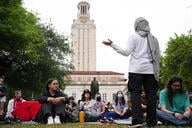You have /5 articles left.
Sign up for a free account or log in.
Imagine the following hypothetical scenario. Jen is a college first-year student. She attended a public high school in which randomly selected students received iPads as part of an innovative curricular grant project. Jen was fortunate enough to be one of the selected students. She loved writing, reading and using the computer – sometimes for fun, sometimes for homework.
Jen scored in the 78th percentile on the SATs, played on a varsity athletic team, and late in her senior year, showed an aptitude for and interest in photography. She worked during the summer. One of her two parents is a college graduate. Their combined income approximates $95,000.
Jen was accepted to a variety of colleges and universities, and decided to attend a mid-sized university, largely because of the financial aid package, and because its website showcased a new photography major.
Jen was bemused after her first week in college. She is a product of iPhones, smartboards, iPads and text messaging, and yet her classroom was devoid of technological gadgetry. Her professors lecture, sometimes with PowerPoint, sometimes without. They talk about research as if it is something to be done in a library, and not on one’s lap or in one’s hand.
The preceding example may or may not sound familiar to many educators and students, but it is likely to be the norm in the next few years. Our students process, retrieve and garner information in ways unimaginable a few years ago, if not months ago. We faculty, trained with card catalogs, photocopy packets, and reserve reading, are rapidly becoming living, breathing anachronisms.
Challenges abound – for Jen and for us. Students’ demand for infotainment need not be satisfied, but so too one should not dismiss the reality that such demand is a creation of cultural forces not easily ignored. Similarly, Jen’s technological acumen is not unique, nor is her professor’s lack of it. That divide is only likely to grow. Even as universities attempt to prepare faculty with info-tech workshops and seminars, today’s teenager is going to be more proficient at web design, for example, than your typical 50-something year-old English or sociology professor.
Years ago, I would find an article – in hard copy or on microfiche. If the abstract looked relevant, I would print out the article and read it. Now the digital version of that article is available with the touch of a few clicks. Which article abstracts does one read? How does one choose? The plethora of data is overwhelming for me; it must be daunting for someone without years of experience filtering and culling information.
We need to devote some time to rethink how we – faculty and students alike – read, write, study, research, and more generally, learn. As a relatively new dean, I have asked faculty to rethink their classes, not by tweaking a syllabus by adding or removing a book, but by thinking about today’s and tomorrow’s students. While this process has just commenced, I find that, generally, faculty are eager to accept the challenge. They too realize that today’s students are showing different learning skills than but a few years ago. Anecdotal evidence suggests that they are comfortable with facts – dates, times, and places – but less secure questioning ambiguous or conflicting ideas. Perhaps this is nothing new. After all, contextual analysis is a tricky and sometimes exhausting enterprise.
We have to develop those skills by adapting our own pedagogy and modifying our formal training. Many of us still love the book – the smell, the spine, and the ability to write in the margins. But we need not be intellectual dinosaurs. Perhaps there is something to be said about digital textbooks, replete with high-pixel digital images, highlighting and note-taking capabilities, podcasts and moving cameras. (The new digital art history books are mesmerizing.)
How do we develop those skills? The responsibility, I would suggest first lies with provosts, deans and chairs. Instead of wasting valuable time on weekly meetings about the status quo, we should be listening carefully to college-bound high school students. Our faculty should be present too, perhaps sitting in the background taking copious notes (either on a memo pad or an iPad). Provosts should make technology in the classroom the theme of their faculty retreats, perhaps for the next year or two, if only because technological advancements find the marketplace faster than the glacially slow academic calendar.
We then should be holding a series of summits with our information technology departments, not as we always do to discuss next year’s budget, but to imagine together what the next five or ten years of classroom instruction will look like, and to develop specific strategies for implementing that vision. Perhaps it will require a million dollars. Perhaps, indeed. If so, then it is time for us deans to raise funds, or for us quickly to develop strategic partners with computer companies.
There are no more Luddites in the university. I should know. I learned how to do chi-squares calculations by hand, and I still believe such a method teaches students how to understand the relationship between two variables. I still have a file cabinet full of journal articles. My fondness for books and bookstores has not dissipated, nor has my passion for reading the hard copy of the newspaper.
Critics may misinterpret this call for action as a desire to teach to the whims of technology. Quite the contrary. Even the able scholar with a fountain pen now uses a laptop and a flash drive. Information abounds – good, bad, true and false. It can be retrieved and stored in ways inconceivable but two years ago. Teaching Jen to discern what is crud and what is critically valuable – in a way that both inspirational and imaginative – is no easy task. Her voracious intellectual appetite must be met with creative energy we have not yet tapped.




